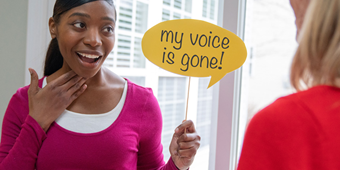- Arthritis/Osteoarthritis
- Back and Spine
- Back Pain
- Bone and Joint Health
- Health Topics
- Joint Conditions/Injuries/Treatment
- Joint Pain/Pain Management
- Spine Health
When Arthritis Is a Pain In the Back

Find Your Perfect Match
Answer a few questions and we'll provide you with a list of primary care providers that best fit your needs.
Ankylosing spondylitis (AS) is a type of arthritis that inflames the vertebrae or bones of the spine, causing pain and stiffness. In more advanced cases, AS can wear down the sacroiliac joints – between the spine and hip bones – and fuse the vertebrae, as bone forms between them.
As a woman, you’re at less risk of AS than men. But if you have relatives who have been diagnosed with AS, your risk could be increased.
AS affects about half a million Americans and tends to run in families. A gene associated with AS – the HLA-B27 gene – is present in more than 95 percent of Caucasian Americans with the condition, compared to only 50 percent of African Americans with AS. (However, many people with the HLA-B27 gene do not have AS.)
Ankylosing spondylitis can present differently in women – with symptoms starting in the neck rather than lower back.
Symptoms Of Ankylosing Spondylitis
Symptoms most commonly begin between the ages of 17 and 35, but ankylosing spondylitis can also affect children and older adults. The most common early symptoms are frequent pain and stiffness in the lower back and buttocks. However, ankylosing spondylitis can present differently in women – with symptoms starting in the neck rather than lower back.
And for some – particularly children – the pain begins in a peripheral joint – for instance, the hip, knee, ankle, elbow, heel, or shoulder. In these cases, the pain is caused by inflammation around the area where a ligament or tendon attaches to bone.
AS symptoms, which vary person to person, may include:
- Back pain that often worsens at night during rest, leading to pain and stiffness in the morning. (A warm shower and light exercise or activity can provide some relief.)
- Straight, stiff spine
- Appetite loss
- Mild fever
- Weight loss
- Fatigue
- Anemia
- Stooped posture as a result of bending forward to relieve pain
- Stiffness and pain that spread up the spine, into the neck, along with pain and tenderness spreading to the ribs, shoulder blades, hips, thighs, and heels
- Difficulty breathing deeply when the inflammation of AS affects joints between the ribs and spine
- Mild eye inflammation – iritis or uveitis – which affects about a third of people with AS. Symptoms include painful, watery, red eyes, blurred vision and sensitivity to bright light.
- Damage to organs such as the heart, lungs, and eyes
- Skin rashes
- Gastrointestinal illnesses such as Crohn's disease or ulcerative colitis
Diagnosis

Some AS symptoms resemble those of other conditions, so see your health care provider for an examination and diagnosis.
Your health care team may use the following diagnostic tools:
- Physical exam to determine sites of inflammation, pain, and tenderness and to check for limits to spinal mobility
- Personal and family medical history of AS
- X-rays to check for signs of the inflammation of ankylosing spondylitis, including possible erosion of the sacroiliac (SI) joints. Your doctor may recommend an MRI, because changes in the SI joints can be undetectable by X-ray before seven to 10 years into the disease process.
- Blood work, including a test for the HLA-B27 gene. More than 95 percent of Caucasian Americans with AS have the gene, as do 80 percent of AS patients from Mediterranean countries and 50 percent of African American AS patients.
- Erythrocyte sedimentation rate (ESR) test, which looks at how quickly red blood cells fall to the bottom of a test tube. The blood's proteins clump together and become heavier during inflammation and swelling, making them fall faster in an ESR test.
Treatment For Ankylosing Spondylitis
Your health care provider will prescribe treatment based on your symptoms, age, severity of your condition, and general health. The aims of treatment: to reduce pain and stiffness, help you maintain as normal a lifestyle as possible, and prevent deformities.
Treatment may include:
- Medication to reduce pain, inflammation, and swelling. This may include nonsteroidal anti-inflammatory medicines, tumor-necrosis-factor blockers, interleukin-17A inhibitors, disease-modifying antirheumatic medicines, and corticosteroids. Muscle relaxants and pain relievers may also be prescribed to relieve severe pain and muscle spasms.
- Exercise and physical therapy. Staying active can help reduce AS pain. An exercise program designed especially for you by a physical therapist can help you maintain good posture and flexibility, strengthen back muscles, and lessen pain. Lifestyle changes can improve your quality of life.
- Applying heat/cold to relax muscles and reduce joint pain
- In severe cases, posture-correcting surgery and surgery to replace a joint, place rods in the spine, or remove parts of thickened and hardened bone
When you notice symptoms, call your health care provider to help take advantage of treatment as soon as possible.
Find Your Perfect Match
Answer a few questions and we'll provide you with a list of primary care providers that best fit your needs.
Source: Spondylitis Association of America; Arthritis Foundation




